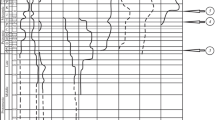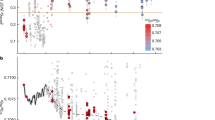Abstract
Comparison of results for the original burial rate of carbonate sediments over Phanerozoic time, as calculated using the GEOCARBSULFvolc model, with their rate of preservation to the present (survival rate) shows a considerable loss of mass, partly by subduction of oceanic crust, during the past 250 million years. Before that time, despite the evidence that preserved Paleozoic carbonates appear to have been deposited only in shallow water, we contend that there was also inorganic deposition of carbonates in the Paleozoic deep sea with subsequent loss by subduction. Inorganic carbonate deposition may have been abetted by the vastly different seawater and atmospheric composition for most of the Paleozoic than those of post-Cretaceous and end Paleozoic–early Mesozoic times. The hypothesis helps to explain the loss of mass greater than that predicted for shallow-water carbonates prior to 250 Ma.


Similar content being viewed by others
References
Arvidson RS, Mackenzie FT, Guidry M (2006) MAGic: a phanerozoic model for the geochemical cycling of major rock-forming components. Am J Sci 306(3):135–190
Berner RA (2004) The phanerozoic carbon cycle: CO2 and O2. Oxford University Press, NY, p 150
Berner RA (2006a) GEOCARBSULF: a combined model for phanerozoic atmospheric O2 and CO2. Geochim Cosmochim Acta 70:5653–5664
Berner RA (2006b) Inclusion of weathering of volcanic rocks in the GECARBSULF model. Am J Sci 306:295–302
Berner RA (2008) Addendum to “Inclusion of the weathering of volcanic rocks in the GEOCARBSULF model”. Am J Sci 308:100–103
Berner RA (2009) Phanerozoic atmospheric oxygen: new results using the GEOCARBSULF model. Am J Sci 309:603–606
Berner EK, Berner RA (1996) The global environment: water, air and geochemical cycles. Prentice-Hall, Upper Saddle River 376
Bluth GJ, Kump LR (1991) Phanerozoic paleogeology. Am J Sci 291:284–308
Boss SK, Wilkinson BH (1991) Planktogenic-eustatic control on cratonic-oceanic carbonate accumulation. J Geol 99:497–593
Garrels RM, Mackenzie FT (1971) Evolution of sedimentary rocks. W. W. Norton & Company, Inc, NY, p 397
Garrels RM, Mackenzie FT (1972) A quantitative model for the sedimentary rock cycle. J Mar Chem 1:27–41
Garrels RM, Lerman A, Mackenzie FT (1976) Controls of atmospheric O2 and CO2: past, present, and future. Am Scientist 63:306–315
Given RK, Wilkinson BH (1987) Dolomite abundance and stratigraphic age: constraints on rates and mechanisms of Phanerozoic dolostone formation. J Sedim Petrology 57:1068–1079
Gregor CB (1985) The mass-age distribution of Phanerozoic sediments. In: Snelling NJ (ed) Geochronology and the geologic record, Geol Soc London Mem 10:284–289
Hay WW (1985) Potential errors in estimates of carbonate rock accumulating through geologic time. In: Sundquist ET, Broecker WS (eds) The carbon cycle and atmospheric CO2: natural variations archean to present, Geophys Mon 32:573–584
Hay WW, Sloan JL, Wold CN (1988) Mass/age distribution and composition of sediments on the ocean floor and the global rate of sediment subduction. J Geophys Res 93:14933–14940
Hay WW, Wold CN, Soding E, Flugel S (2001) Evolution of sediment fluxes and ocean salinity, In: Merriam DF, Davis JC (eds) Geologic modeling and simulations: sedimentary systems. Kluwer Academic/Plenum, Dordrecht, pp 153–167
Land LS, Macpherson GL (1992) Origin of saline formation waters, Cenozoic section Gulf of Mexico sedimentary basin. Am Assoc Pet Geol Bull 76:1344–1362
Lee J, Morse J (2010) Influences of alkalinity and pCO2 on CaCO3 nucleation from estimated Cretaceous composition seawater representative of “calcite seas”. Geology 38:115–118
Lowenstein TK, Timofeeff MN, Brennan ST, Hardie LA, Demicco RV (2001) Oscillations in Phanerozoic seawater chemistry: evidence from fluid inclusions. Science 294:1086–1088
Mackenzie FT, Lerman A (2006) Carbon in the geobiosphere-earth’s outer shell. Springer, Dordrecht 402
Mackenzie FT, Morse JW (1992) Sedimentary carbonates through Phanerozoic time. Geochim Cosmochim Acta 56:3281–3295
Mackenzie FT, Arvidson RS, Guidry M (2008) Chemostatic modes of the ocean-atmosphere-sediment system through Phanerozoic time. Mineral Magazine 72:329–332
Ronov AB (1980) Osadochnaya Obolochka Zemli (Kolichestvennyye Zakonomernosti Stroyeniya Sostava i Evolyutsii. Nauka, Moscow, p 80
Ronov AB (1982) The earth’s sedimentary shell (quantitative patterns of its structure, composition, and evolution). Internatl Geol Rev 24:175–196
Steuber T, Veizer J (2002) A Phanerozoic record of plate tectonic control of seawater chemistry and carbonate accumulation. Geology 30:1123–1126
Veizer J (1988) The evolving exogenic cycle. In: Gregor CB, Garrels RM, Mackenzie FT, Maynard JB (eds) Chemical cycles in the evolution of the earth. John Wiley and Sons, pp 175–220
Veizer J, Mackenzie FT (2004) Evolution of sedimentary rocks. In: Mackenzie FT (ed) Sediments, diagenesis, and sedimentary rocks, vol 7, treatise on geochemistry, Holland HD, Turekian KK (series eds), Elsevier-Pergamon, Oxford, pp 369–407
Wilkinson BH, Walker JCG (1989) Phanerozoic cycling of sedimentary carbonate. Am J Sci 289:525–548
Acknowledgments
We both acknowledge the important influence that John Morse had on our research and regret deeply his untimely demise. This paper we feel is an appropriate tribute to John and to his outstanding contributions to the study of sedimentary carbonates. RAB remembers his collaboration with John, when John was a graduate student at Yale, on the kinetic origin of the lysocline and CaCO3 compensation depth. John was a student who learned less from RAB than RAB learned from him. FTM first met John during John’s graduate student days in a carbonate biogeochemistry class that FTM taught at the Bermuda Biological Station for Research. From that moment on, John and FTM were friends and had a productive scientific collaboration resulting in publication of the book Geochemistry of Sedimentary Carbonates (1990) and a number of scientific papers. FTM acknowledges NSF Grant OCE 07-49401 for partial support of this research.
Author information
Authors and Affiliations
Corresponding author
Rights and permissions
About this article
Cite this article
Berner, R.A., Mackenzie, F.T. Burial and Preservation of Carbonate Rocks Over Phanerozoic Time. Aquat Geochem 17, 727–733 (2011). https://doi.org/10.1007/s10498-010-9113-0
Received:
Accepted:
Published:
Issue Date:
DOI: https://doi.org/10.1007/s10498-010-9113-0




